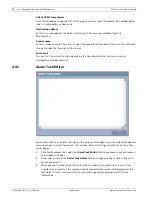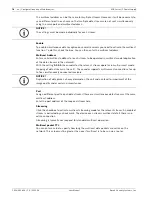
76
en | Configuration using a Web browser
MIC Series IP Power Supply
F.01U.265.804 | 1.6 | 2012.08
User Manual
Bosch Security Systems, Inc.
SNMP
The encoder supports the SNMP V2 (Simple Network Management Protocol) for managing
and monitoring network components, and can send SNMP messages (traps) to IP addresses.
The unit supports SNMP MIB II in the unified code. If you wish to send SNMP traps, enter the
IP addresses of one or two required target devices here.
If you select On for the SNMP parameter and do not enter an SNMP host address, the encoder
does not send the SNMP traps automatically, but only replies to SNMP requests. If you enter
one or two SNMP host addresses, SNMP traps are sent automatically. Select Off to deactivate
the SNMP function.
1. SNMP host address / 2. SNMP host address
If you wish to send SNMP traps automatically, enter the IP addresses of one or two required
target units here.
SNMP traps
You can select which traps are to be sent.
1.
Click Select. A list is opened.
2.
Click the checkboxes to select the required traps. All the checked traps will be sent.
3.
Click Set to accept the selection.
Authentication
If a RADIUS server is employed in the network for managing access rights, authentication
must be activated here to allow communication with the unit. The RADIUS server must also
contain the corresponding data.
To configure the unit, you must connect the encoder directly to a computer. This is because
communication via the network is not enabled until the Identity and Password parameters
have been set and successfully authenticated.
Identity
Enter the name that the RADIUS server is to use for identifying the encoder.
Password
Enter the password that is stored in the RADIUS server.
RTSP port
If necessary, select a different port for the exchange of the RTSP data from the list. The
standard RTSP port is 554. Select Off to deactivate the RTSP function.
UPnP
You can activate the Universal Plug and Play (UPnP) function. If the function is turned on, the
unit responds to requests from the network and is automatically registered on the requesting
computers as a new network device. For example, access to the unit can then be made using
Windows Explorer without knowledge of the IP address of the unit.
This function should not be used in large installations because of the variety of potential
registration notifications.
NOTICE!
To use the UPnP function on a computer, both the Universal Plug and Play Device Host and
SSDP Discovery Service must be active in Windows XP and Windows 7.






























